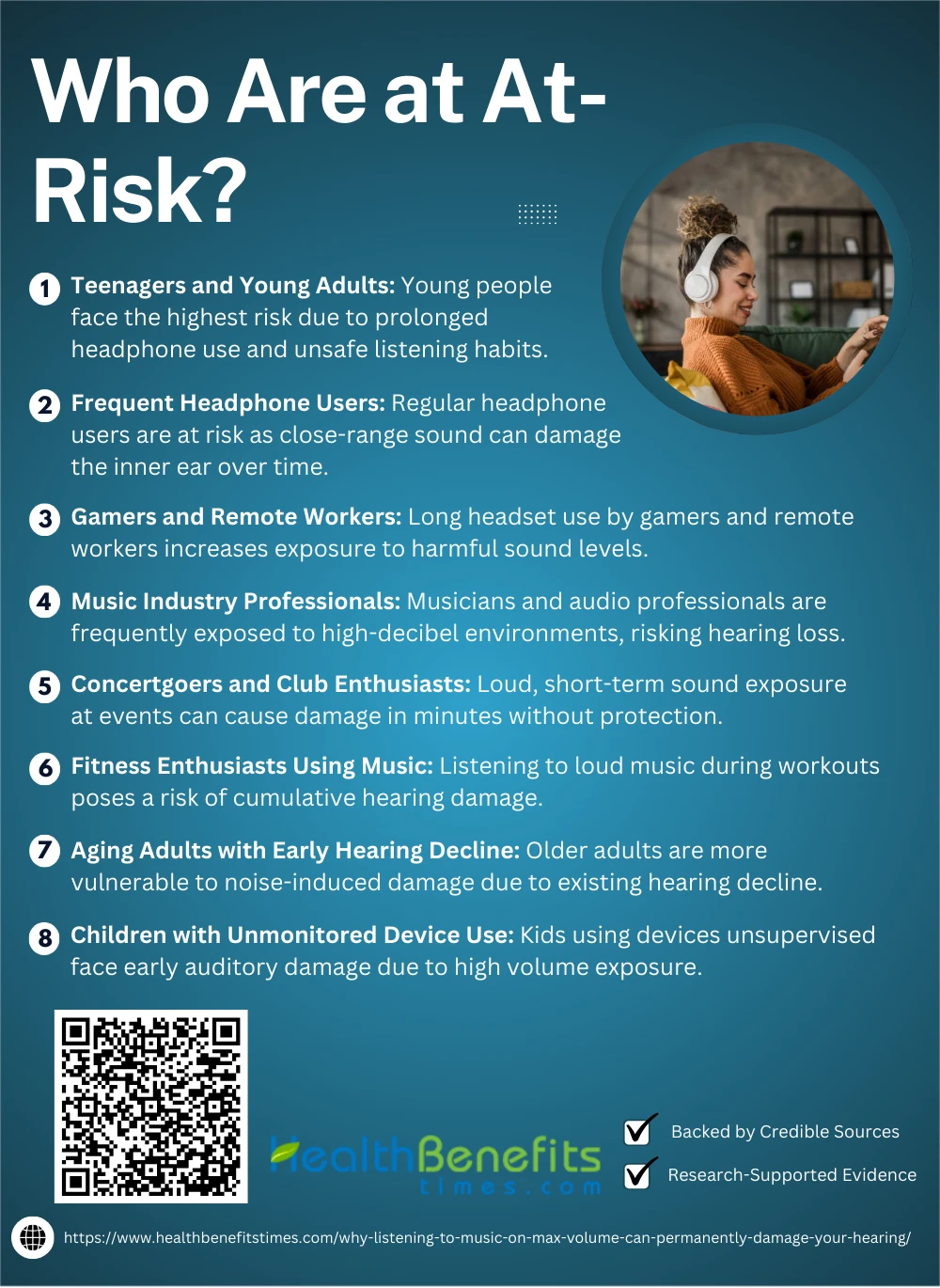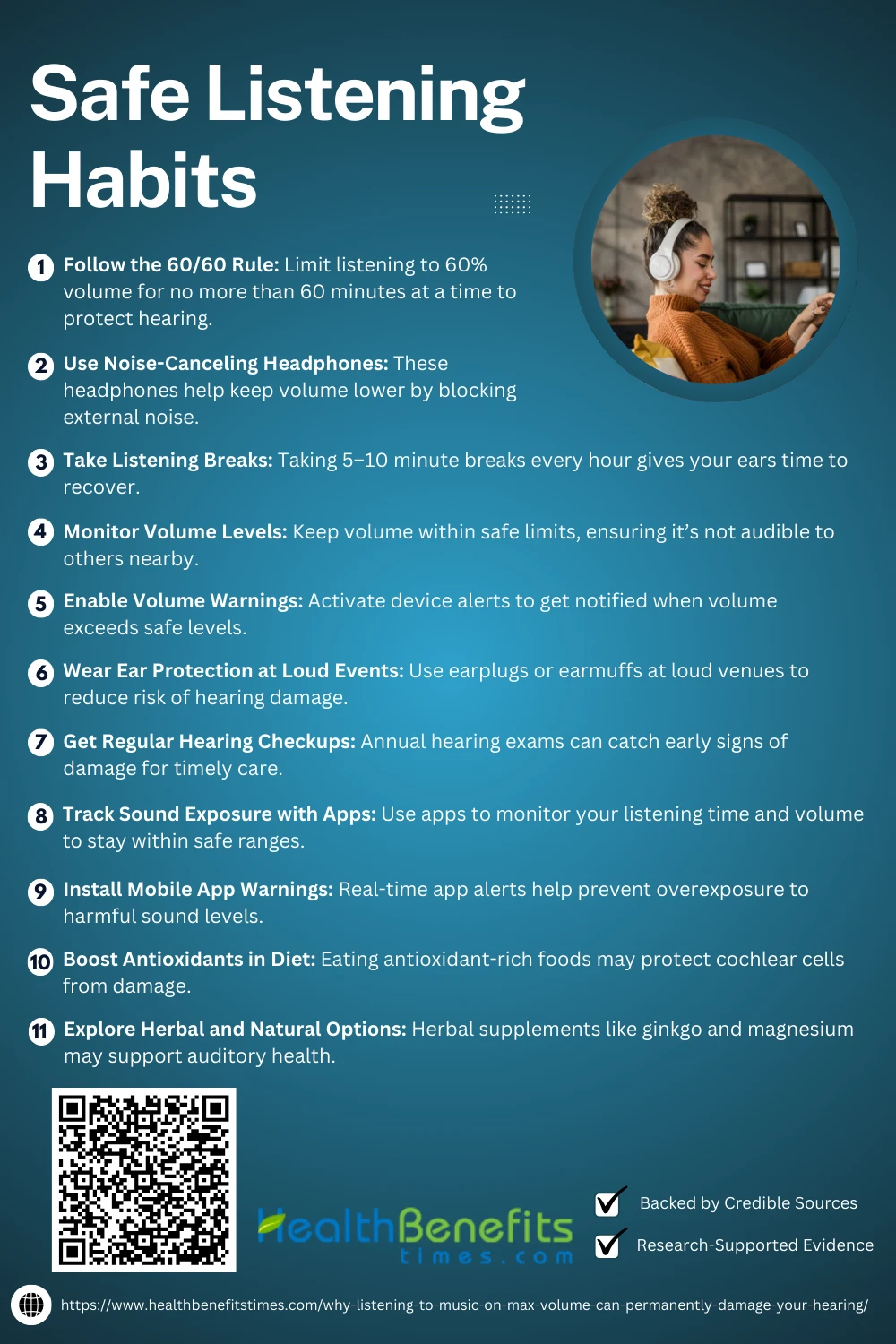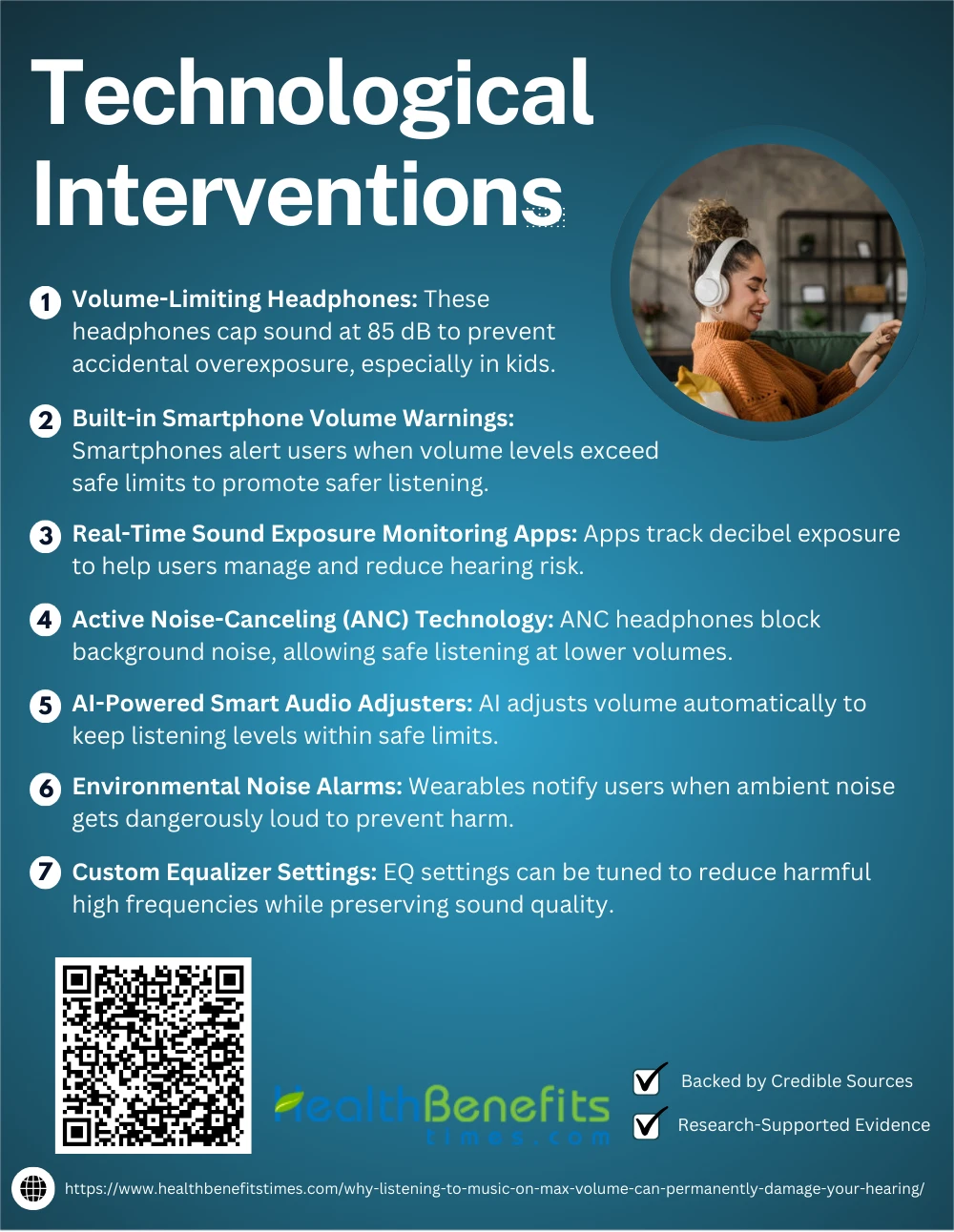- Music is an organized combination of sounds, rhythms, and harmonies created for emotional or artistic expression.
- Listening to music on maximum volume can damage delicate inner ear hair cells, leading to irreversible hearing loss.
- Prolonged exposure to loud sound—especially through headphones—accelerates conditions like tinnitus and noise-induced hearing loss (NIHL).
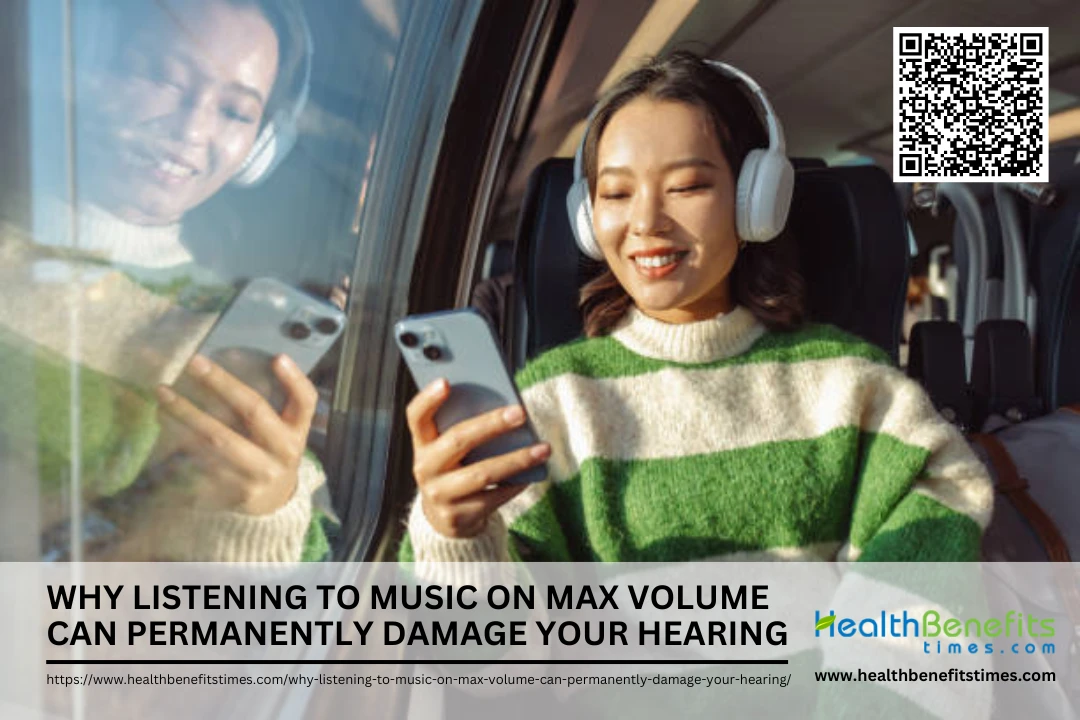 Music is a structured combination of sound elements—melody, rhythm, and harmony—that evokes emotional and cognitive responses in humans. From streaming your favorite songs to attending concerts, music is deeply woven into our daily lives. However, the way we consume music—especially through personal listening devices at high volumes—has raised serious public health concerns. Studies show that exposure to sounds exceeding safe decibel thresholds can damage the delicate hair cells in the cochlea, leading to irreversible hearing loss. For instance, adolescents who use headphones at high volume for extended periods are at a significantly higher risk of developing music-induced hearing loss (MIHL). In fact, the World Health Organization estimates that over 1.1 billion young people globally could be at risk due to unsafe listening practices. These alarming trends call for immediate awareness and preventive action to safeguard our hearing health.
Music is a structured combination of sound elements—melody, rhythm, and harmony—that evokes emotional and cognitive responses in humans. From streaming your favorite songs to attending concerts, music is deeply woven into our daily lives. However, the way we consume music—especially through personal listening devices at high volumes—has raised serious public health concerns. Studies show that exposure to sounds exceeding safe decibel thresholds can damage the delicate hair cells in the cochlea, leading to irreversible hearing loss. For instance, adolescents who use headphones at high volume for extended periods are at a significantly higher risk of developing music-induced hearing loss (MIHL). In fact, the World Health Organization estimates that over 1.1 billion young people globally could be at risk due to unsafe listening practices. These alarming trends call for immediate awareness and preventive action to safeguard our hearing health.
The Science of Hearing
The human ear consists of three main parts: the outer, middle, and inner ear. The outer ear includes the pinna and auditory canal, funneling sound toward the eardrum. The middle ear houses three tiny bones (ossicles) that amplify vibrations. Finally, the inner ear contains the cochlea, a spiral-shaped structure critical for hearing. These structures work together as an efficient system for capturing and channeling sound energy.
Once sound reaches the cochlea, it undergoes complex neural processing. Vibrations create fluid waves inside the cochlea that stimulate specific regions based on pitch. These mechanical signals are converted into electrical impulses by sensory hair cells and transmitted via the auditory nerve to the brain’s auditory cortex, where they are interpreted as meaningful sound. (1)
Central to this process are the cochlear hair cells, located on the basilar membrane. These cells are highly specialized and irreplaceable. When exposed to excessively loud sounds, especially over time, the delicate stereocilia atop these cells can be damaged or destroyed, leading to sensorineural hearing loss. Unfortunately, human hair cells do not regenerate, making the damage permanent and cumulative (Sharp, 2025). (2)
What Is Considered “Too Loud”?
Sound becomes hazardous when it exceeds safe exposure thresholds, typically 85 decibels (dB) over prolonged periods. Prolonged exposure beyond this limit—like listening to music at 100 dB for just 15 minutes—can cause permanent hearing loss. According to Lutz et al. (2024), such noise levels damage inner ear structures. (3) Moreover, Au et al. (2024) confirm that brief spikes above 100 dB drastically increase risk. (4)
Signs of Hearing Damage
Early signs of hearing damage can be subtle but serious. You might notice ringing in your ears, muffled sounds, or trouble understanding speech—especially in noisy environments. These signs shouldn’t be ignored.
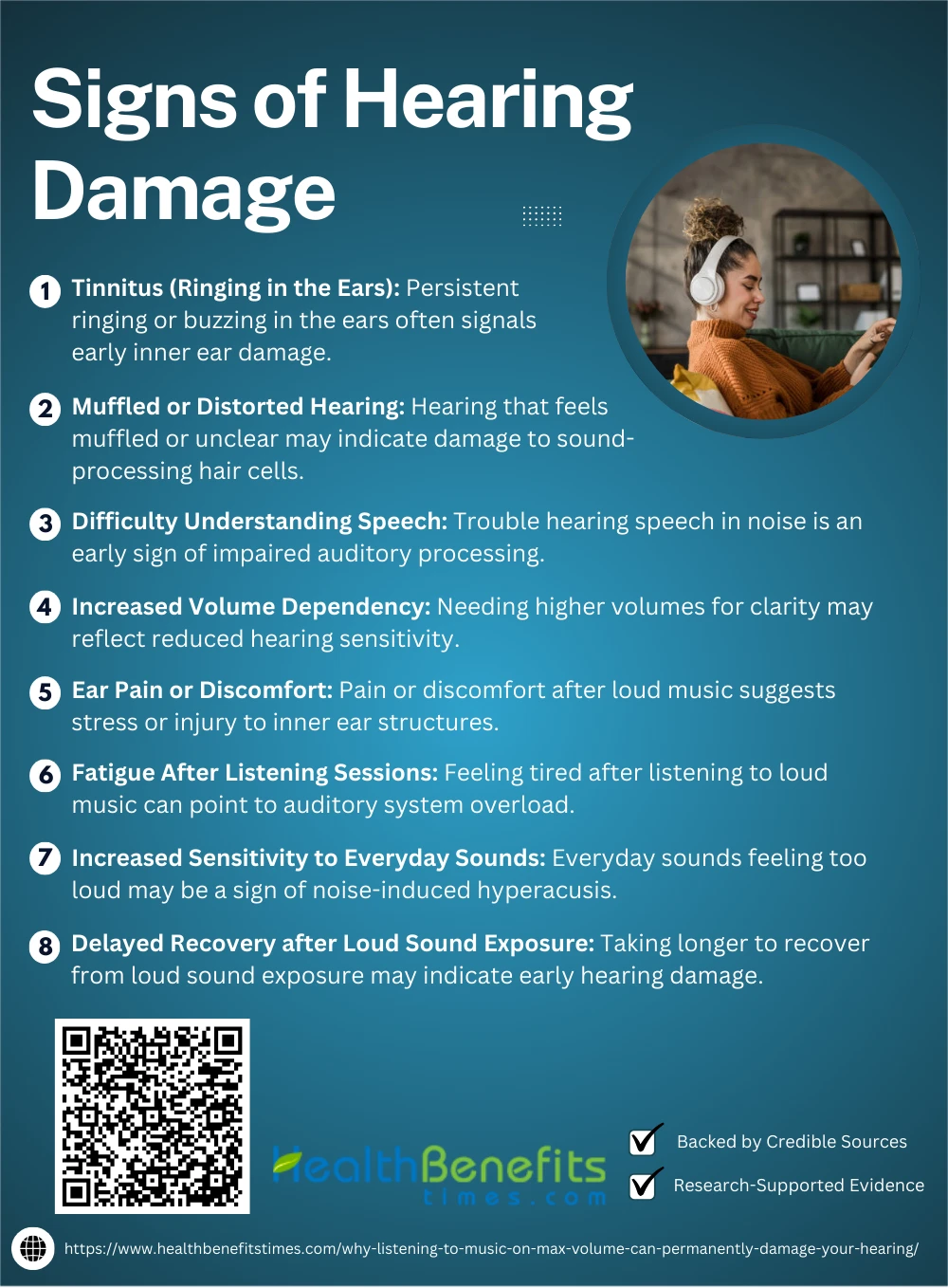 1. Tinnitus (Ringing in the Ears)
1. Tinnitus (Ringing in the Ears)
Tinnitus, often described as a persistent ringing or buzzing sound, is a critical early indicator of auditory damage from loud music. Prolonged exposure to high decibel levels can damage hair cells in the inner ear, leading to this phantom noise sensation. (5) The condition frequently precedes permanent hearing loss. (6) Early intervention and noise exposure control are essential, as supported by WHO’s hearing protection guidelines. (7)
2. Muffled or Distorted Hearing
Muffled or distorted hearing following music exposure may suggest temporary or even permanent threshold shifts in auditory perception. This symptom signals damage to cochlear hair cells responsible for sound clarity. (8) According to NCBI, repeated exposure can result in irreversible sensory-neural hearing loss. (9) WHO underscores the importance of safe listening habits to prevent early auditory decline. (10)
3. Difficulty Understanding Speech
Difficulty understanding speech, especially in noisy environments, is a subtle but vital early sign of noise-induced hearing damage. High-volume music can degrade the cochlea’s ability to process speech frequencies. (11) According to NCBI, this issue often precedes measurable hearing loss. (12) The WHO highlights that untreated hearing difficulty significantly impacts social and cognitive function, urging early preventive action. (13)
4. Increased Volume Dependency
Constantly increasing music volume to achieve clarity may signal emerging hearing damage. This “volume creep” results from reduced auditory sensitivity due to overstimulation of ear structures. (14) Research from NCBI confirms that higher volume dependence is often linked with early inner ear damage. (15) The WHO advocates limiting exposure to loud sounds as a preventive measure against such habits. (7)
5. Ear Pain or Discomfort
Ear pain or discomfort after listening to loud music may signal early hearing damage. Prolonged exposure to high decibel levels can cause stress on inner ear structures, leading to discomfort and even permanent damage. The CDC confirms that loud music contributes to noise-induced hearing loss. (16) The World Health Organization highlights early symptoms like pain and sensitivity. (13) NIH research further supports the link between pain and early auditory stress. (17)
6. Fatigue After Listening Sessions
Experiencing fatigue after listening to loud music may indicate auditory overload and potential hearing harm. According to the CDC, listening fatigue can result from prolonged exposure to high-volume sounds, leading to overstimulation of the auditory system. (16) The NIH notes that listening fatigue may signal early inner ear strain. (18) Furthermore, the WHO stresses the importance of recognizing fatigue as an early warning sign for noise-induced hearing loss. (19)
7. Increased Sensitivity to Everyday Sounds
If everyday sounds suddenly seem louder or uncomfortable, it could be a warning sign of hearing damage from loud music. This condition, known as hyperacusis, can result from prolonged noise exposure. According to the NIH, sound sensitivity is linked to cochlear damage. (20) The CDC also emphasizes how excessive volume strains the auditory system. (16) Additionally, WHO lists increased sensitivity among early auditory risk indicators. (13)
8. Delayed Recovery after Loud Sound Exposure
Struggling to recover from a loud concert or prolonged headphone use may signal early hearing damage. Research from the NIH shows that delayed auditory recovery reflects temporary threshold shifts, a precursor to permanent damage. (21) The CDC highlights how repeated exposure to intense sound can delay inner ear recovery. (16) The WHO also flags prolonged recovery as a red flag for long-term hearing health. (19)
How Music on Max Volume Can Permanently Damage Your Hearing
Listening to music at maximum volume can harm delicate hair cells in your inner ear. Once damaged, these cells don’t regenerate, leading to permanent hearing loss and long-term auditory problems.
 1. Inner Ear Hair Cells Get Damaged
1. Inner Ear Hair Cells Get Damaged
Listening to music at maximum volume can irreversibly damage the delicate hair cells in the cochlea. These sensory cells vibrate in response to sound and transmit auditory signals to the brain. When exposed to intense sound pressure levels, they can bend or break, resulting in permanent hearing loss since they cannot regenerate. According to ASHA, excessive loudness moves inner ear fluid forcefully, overstimulating hair cells. (22) The Cleveland Clinic also highlights that high-decibel exposure can damage these cells in minutes. (23) NIH reports that once destroyed, these hair cells never regrow in humans. (24) A study by Harvard Medical School emphasizes the role of these cells in maintaining auditory clarity. (25) Moreover, Mayo Clinic underlines that continued exposure to noise compromises long-term hearing health. (26)
2. Max Volume Hits Dangerous Decibel Levels
Modern headphones can output sound levels exceeding 100 to 110 decibels, which can start causing hearing damage in just minutes. According to the World Health Organization (WHO), exposure to sound above 85 dB becomes hazardous over time. (27) CDC confirms that common devices at full volume exceed safe limits. (16) The American Academy of Audiology warns that sound above 100 dB can damage hearing within 15 minutes. NIH adds that young people especially are at risk due to prolonged headphone use. (28) Finally, Johns Hopkins Medicine points out that anything above 85 dB requires protective measures to prevent damage.
3. Hearing Loss Happens Fast
Hearing loss from loud music can begin much faster than people expect. At 100 decibels, permanent damage may occur in just 15 minutes, as emphasized by the CDC. (16) The WHO notes that young listeners are especially vulnerable. (27) According to NIH, once auditory hair cells are damaged, hearing loss is irreversible. (24) Johns Hopkins Medicine confirms that even short, intense exposures are harmful. The Cleveland Clinic adds that full-volume headphone use can impair hearing in mere minutes. (23)
4. Repeated Exposure = Cumulative Damage
Repeated exposure to loud music gradually compounds damage to your hearing system. According to ASHA, even moderate levels, if consistent, can wear down inner ear hair cells. (22) The NIH warns that this cumulative trauma is typically unnoticed until irreversible damage occurs. (24) Harvard Medical School explains that recurring stress on the cochlea accelerates hearing loss. (25) The American Academy of Audiology and WHO reinforce that repeated loud sound exposure is a major contributor to lifelong auditory decline. (13)
5. Tinnitus: That Ringing Is a Red Flag
Tinnitus—often described as a persistent ringing or buzzing in the ears—can develop after prolonged exposure to loud music. According to the American Tinnitus Association loud noises are a leading trigger of this condition. The National Institute on Deafness and Other Communication Disorders (NIH) emphasizes that damage to inner ear hair cells can generate phantom auditory signals. (29) Mayo Clinic links tinnitus to high-volume music. (30) Harvard Health discusses how loud sound initiates neural changes. (31) Finally, Cleveland Clinic confirms that noise-induced tinnitus may become chronic and irreversible.
6. Your Brain Starts Ignoring the Warning Signs
Prolonged exposure to loud music causes your brain to adapt and dull its response to harmful sound levels, increasing risk. The National Institutes of Health explains that desensitization leads individuals to overlook early hearing damage. (24) Harvard Medical School highlights the brain’s plasticity in adjusting to abnormal noise exposure. (25) Johns Hopkins Medicine warns that this auditory tolerance masks danger. CDC affirms that perceived “normal” volumes may still be harmful. (16) The WHO also stresses that repeated exposure rewires auditory perception thresholds. (13)
7. Noise-Induced Hearing Loss (NIHL) Is Silent at First
Noise-Induced Hearing Loss (NIHL) results from prolonged or sudden exposure to high-decibel sound, like music on max volume. The NIH states that such exposure damages inner ear hair cells. (24) According to the CDC, headphones at full blast can exceed safe limits. (16) Johns Hopkins Medicine highlights young adults’ rising risk. The American Academy of Audiology links music habits to NIHL. Finally, the WHO warns that over 1 billion people are at risk due to unsafe listening. (27)
8. Gradual Loss Becomes Permanent
Hearing loss from loud music often develops gradually and becomes permanent before symptoms are noticed. The Mayo Clinic explains that persistent loud noise damages cochlear structures slowly. (26) Harvard Medical School confirms that cumulative damage to inner ear cells leads to irreversible loss. (25) NIH adds that recovery isn’t possible once those cells are lost. (32) ASHA also reports that early signs are subtle. The Cleveland Clinic stresses the importance of prevention, as treatment only manages—not reverses—the condition.
9. Headphones Directly Impact the Ear Canal
Using headphones at maximum volume channels sound waves directly into the ear canal, intensifying the risk of auditory damage. According to the Cleveland Clinic, earbuds sit closer to the eardrum and amplify pressure. (23) The CDC confirms that this proximity boosts exposure levels. (16) NIH highlights that intense vibrations affect cochlear hair cells. (24) ASHA warns that frequent use causes lasting harm. Additionally, Johns Hopkins Medicine stresses that such direct input accelerates damage.
Who are at At-Risk?
People at risk of hearing loss from maximum volume exposure include frequent headphone users, musicians, factory workers, and concertgoers. Prolonged loud sound can damage inner ear cells, causing permanent hearing loss.
Teenagers and young adults are the most vulnerable group when it comes to hearing loss from loud music. The World Health Organization (WHO) reports that over 1.1 billion young individuals globally are at risk due to unsafe listening practices. (13) Prolonged use of headphones at high volumes, particularly in leisure settings, contributes heavily to this risk, often without them realizing the cumulative impact on their hearing health.
2. Frequent Headphone Users
Individuals who regularly use headphones for extended periods—whether for music, podcasts, or media consumption—face elevated risk. Devices like in-ear monitors and earbuds are particularly harmful as they sit close to the eardrum. According to the Cleveland Clinic, this proximity intensifies sound pressure, making inner ear structures more prone to damage even at moderate volume levels over time. (23)
3. Gamers and Remote Workers
Gamers, streamers, and remote workers who wear headsets for long periods are exposed to continuous auditory stimulation. Often, these individuals are unaware of the cumulative sound exposure. The Centers for Disease Control and Prevention (CDC) highlights that both duration and volume contribute to Noise-Induced Hearing Loss (NIHL), making it crucial for these users to take regular breaks and monitor volume levels. (16)
4. Music Industry Professionals
Professionals in the music and entertainment industry—such as musicians, DJs, sound engineers, and producers—frequently encounter high-decibel environments during rehearsals, performances, and studio sessions. The National Institutes of Health (NIH) identifies this population as being at a high risk for NIHL. (24) Without protective measures like custom earplugs or sound isolation, their repeated exposure to loud sound can lead to irreversible damage.
5. Concertgoers and Club Enthusiasts
Regular attendees of concerts, clubs, and music festivals often experience sound levels above 100 decibels, a threshold at which damage can begin in under 15 minutes. Johns Hopkins Medicine stresses that such short-term but intense exposures can be harmful without hearing protection like earplugs. Unfortunately, many don’t perceive the risk due to the excitement and temporary nature of the events.
6. Fitness Enthusiasts Using Music
People who listen to music at full blast during workouts, runs, or gym sessions may unknowingly damage their hearing. Loud music is often used to boost energy or mask background noise, leading to higher volume levels. The American Academy of Audiology warns that this habitual behavior can lead to long-term auditory damage, especially when workouts exceed an hour and are performed daily.
7. Aging Adults with Early Hearing Decline
Older adults already experiencing age-related hearing loss (presbycusis) are more susceptible to additional damage from loud music. According to the Mayo Clinic, the natural decline in hearing sensitivity can be worsened by noise exposure, even if it seems moderate. (26) Amplifying music to compensate for fading hearing can accelerate deterioration and reduce the effectiveness of later hearing interventions.
8. Children with Unmonitored Device Use
Children are increasingly exposed to devices like tablets and smartphones, often with inadequate volume restrictions. Without parental supervision or safe listening guidelines, they may unknowingly expose their developing auditory systems to harmful sound levels. The NIH stresses that early exposure to excessive noise can lead to developmental delays in language and permanent hearing loss, making preventive education and volume-limiting headphones essential. (33)
Safe Listening Habits
Safe listening habits protect your ears from long-term damage. Lowering volume, taking listening breaks, using noise-canceling headphones, and following the 60/60 rule help maintain healthy hearing over time.
The 60/60 rule—listening at 60% volume for no more than 60 minutes—helps reduce the risk of hearing damage. The World Health Organization (WHO), NIH, and CDC recommend this strategy to protect the inner ear from overexposure to loud sound, especially among frequent headphone users. (27) (24) (16)
2. Use Noise-Canceling Headphones
Noise-canceling headphones reduce background noise, allowing users to maintain lower volume levels. According to the CDC, NIH, and Cleveland Clinic, these devices are effective tools for safe listening, especially in loud environments like public transport or gyms. (28) (23) ({% https://www.cdc.gov/nceh/hearing_loss/what_noises_cause_hearing_loss.html trusted %})
3. Take Listening Breaks
Regular breaks from headphone use allow your ears to recover from sound stress. The NIH, CDC, and American Academy of Audiology all recommend 5–10 minute breaks every hour to minimize cumulative damage and reduce the risk of noise-induced hearing loss. (24) (16)
4. Monitor Volume Levels
Actively monitoring volume ensures you stay within safe sound thresholds. The WHO, Mayo Clinic, and Johns Hopkins Medicine recommend using volume limiters and avoiding levels where others can hear your audio, as this typically signals unsafe intensity. (13) (26)
5. Enable Volume Warnings
Volume warning features on smartphones and audio devices alert users when they exceed safe listening levels. The World Health Organization (WHO), NIH, and CDC all recommend enabling such tools to raise awareness and encourage behavioral changes that help prevent noise-induced hearing loss, especially among youth. (27) (16) (24)
6. Wear Ear Protection at Loud Events
Wearing earplugs or earmuffs at concerts, clubs, or sporting events can reduce noise exposure by 15–30 dB. The American Academy of Audiology, Johns Hopkins Medicine, and NIH advocate for hearing protection in loud environments to prevent permanent inner ear damage from short-term, high-decibel exposure. (28)
7. Get Regular Hearing Checkups
Routine hearing exams are essential for detecting early signs of damage, especially among frequent headphone users or those exposed to loud environments. The NIH, Cleveland Clinic, and Johns Hopkins Medicine recommend annual checkups to catch gradual hearing loss early and provide timely intervention to preserve auditory health. (34)
8. Track Sound Exposure with Apps
Monitoring sound exposure using smartphone apps or wearable tech helps users maintain safe listening habits. The World Health Organization (WHO), CDC, and NIH support digital tools that track volume levels and listening time to reduce the risk of noise-induced hearing loss, especially in young listeners. (13) (24) (16)
9. Install Mobile App Warnings
Installing volume-monitoring mobile apps offers real-time alerts when sound exposure exceeds safe limits. The WHO, NIH, and CDC advocate for digital solutions that track decibel levels, enabling users—especially youth—to adjust habits before irreversible damage occurs, fostering self-awareness in listening behaviors. (27) (24) (16)
10. Boost Antioxidants in Diet
Consuming a diet rich in antioxidants like vitamins A, C, and E may protect against hearing loss. The National Institutes of Health (NIH), Harvard T.H. Chan School of Public Health, and Johns Hopkins Medicine highlight that antioxidants can reduce oxidative stress in cochlear cells, helping preserve auditory function, especially in aging populations. (35) (36)
11. Explore Herbal and Natural Options
Herbal and natural supplements like ginkgo biloba, magnesium, and zinc show promise in supporting hearing health. According to NIH, antioxidants in herbs may protect against auditory damage. (37) Johns Hopkins Medicine and Harvard Health also recognize nutritional therapies as complementary strategies to reduce oxidative stress in cochlear cells. (38)
Technological Interventions
Technological interventions like volume-limiting headphones, smartphone hearing alerts, and sound-monitoring apps help prevent hearing loss by controlling exposure to loud sounds and promoting safer listening habits for all users.
Volume-limiting headphones are specifically designed to cap sound output at 85 decibels, the safe threshold recommended by health authorities. This is particularly useful for children and teens who may unknowingly raise the volume to harmful levels. The World Health Organization (WHO) promotes these devices as a primary preventive strategy in safe listening, especially with prolonged use. (27)
2. Built-in Smartphone Volume Warnings
Many smartphones today come equipped with volume warning systems that notify users when listening levels surpass safety recommendations. These automated alerts—based on duration and loudness—encourage real-time volume reduction. The CDC endorses these features as practical safeguards to raise awareness and modify unsafe listening behaviors before hearing is compromised. (16)
3. Real-Time Sound Exposure Monitoring Apps
Apps like SoundPrint or NIOSH Sound Level Meter empower users to monitor decibel levels during headphone use or in the environment. The NIH highlights these as educational tools that track cumulative exposure, allowing listeners to make informed decisions and limit damage from overexposure. (24)
4. Active Noise-Canceling (ANC) Technology
Noise-canceling headphones use advanced microphones and sound-wave inversion to block out background noise, allowing users to listen comfortably at lower volumes. The American Academy of Audiology emphasizes ANC as an effective solution for environments like airplanes, gyms, or public transit—where users otherwise crank up the volume to compete with external sound.
5. AI-Powered Smart Audio Adjusters
Some modern headphones now feature AI-driven volume optimization, which automatically adjusts sound levels based on environmental conditions and listening duration. These systems prevent users from exceeding safe thresholds for too long. According to Johns Hopkins Medicine, such proactive adjustments reduce the risk of unnoticed auditory strain, especially during binge listening sessions.
6. Environmental Noise Alarms
Smartwatches and wearables from brands like Apple or Fitbit now include real-time environmental noise monitoring. These devices issue alerts when ambient noise exceeds safe exposure levels (typically above 85 dB). Harvard Health suggests these alerts help users either reduce listening volume or move away from loud environments. (39)
7. Custom Equalizer Settings
Adjusting equalizer settings—particularly by reducing high-frequency peaks—can significantly lower the risk of damage from sharp, piercing sounds. The NIH explains that treble-heavy sound waves strain the cochlear hair cells most. EQ customization allows users to tailor safer sound profiles without sacrificing listening quality. (28)
Conclusion
Listening to music at maximum volume can cause irreversible damage to your hearing by destroying the delicate hair cells in the inner ear. Once damaged, these cells do not regenerate, leading to permanent hearing loss. Prolonged exposure to loud sounds, especially through headphones or earbuds, increases this risk significantly. Over time, you may experience symptoms like ringing in the ears, difficulty understanding speech, or muffled hearing. To protect your hearing, it’s important to adopt safe listening habits such as lowering the volume, taking breaks, and using protective technology. Your hearing is precious—take steps now to preserve it for the future.



